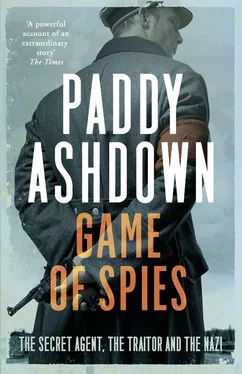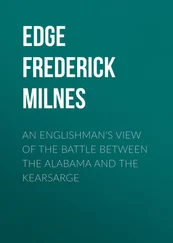Landes thought about it very little, before saying yes.
‘Good,’ said Gielgud, who was the brother of the great actor, John. ‘Then return to your unit. Say nothing to anyone, even your parents, and we will be in touch.’
Some days later Landes received another order: he was to report on 17 March to a flat in Orchard Court, Portman Square, and introduce himself as ‘Robert Lang’.
The door at Orchard Court, a 1930s mansion block, was opened by a man in butler’s uniform, who welcomed him with a butler’s smile. His name was Arthur Parks, and he spoke perfect French, having worked for Barclays Bank in Paris before the war. Parks led the new recruit to a grand room where he was introduced to Captain André Simon, who in peacetime had been a wine merchant. Simon was also brief, informing Landes that he was now formally a member of the Special Operations Executive, with the rank of temporary second lieutenant. He was, henceforth and for the rest of his life, subject to the Official Secrets Act and would receive an initial salary of five guineas a week. Captain Simon then gave Landes £10 with which to buy two khaki shirts and ordered him to report back to Orchard Court with a small overnight bag the following day.
Arriving the next morning at Orchard Court, Landes found he was not alone. He and another nine students, all young men and all of them looking equally uncomfortable in ill-fitting army uniforms, were swiftly introduced to each other using the aliases by which they would be known throughout their period of training. They were a hybrid collection, whose only common feature, as far as Landes could see, was their ability to speak French as a native. Most had dual identities, having been brought up in France as the children of mixed French–British marriages. Some had British parents who had chosen to educate their children in local French schools. One was the son of a well-known Francophone family from Mauritius; he was the first, but by no means last, SOE recruit to come from the tiny British colony.
Introductions over, they were bundled into a small bus and driven out of London, along the A30 through Guildford to the little village of Wanborough, close under the northern flank of the Hog’s Back. Here they turned up a small farm track to a brick-built three-gabled Elizabethan house set about with outhouses, sheds and workers’ cottages.
Wanborough Manor (known by SOE as Special Training School No. 5) was in many ways an odd choice for a spy school. Plainly visible from the road only 200 metres away, and famed for having one of the largest medieval wooden barns in southeast England, it sat right in the middle of the small hamlet of Wanborough. The house had a cellar, used for indoor instruction, a kitchen, a substantial sitting room and a dining room on the ground floor, bedrooms on the top two floors dedicated to staff accommodation and a small church in the grounds, where interdenominational services were held to cater for the needs of SOE’s wide variety of students. Physical training was held on the two lawns, back and front, which during fine weather in the summer months were also employed as occasional outdoor classrooms.
SOE’s trainee agents were not the first unusual visitors to Wanborough. Gladstone’s parliamentary secretary had lived there and the Grand Old Man wrote his resignation speech in the Manor’s study. During Gladstone’s time as prime minister, Queen Victoria had also paid a visit to Wanborough, accompanied by Bismarck. The two marked the occasion by planting two giant sequoias on the front lawn, each adorned with a cast-iron memorial plaque recording the moment. What SOE’s new recruits thought about sitting in the shade of the Iron Chancellor’s memorial tree, while being trained to set Nazi-occupied Europe ‘ablaze’, is not recorded.
There was almost nothing in the hitherto quiet and fastidious life of young Roger Landes that could have prepared him for the next four weeks. Wanborough Manor was a French-speaking microcosm. Its students were cut off from the world, save for carefully vetted letters and occasional accompanied trips over the Hog’s Back to the local pub The Good Intent (Landes drank alcohol only very abstemiously), or to the nearby gravel pit for hand-grenade practice. Landes was woken at dawn every morning from a hard army bed and went straight into PT, followed by a run around the manor house grounds. Then lessons all day, most of them requiring hard physical exertion, which cannot have been made any easier for Landes by his habit (which continued unabated all his life) of smoking sixty cigarettes a day. Soon every muscle of his slight, city-softened body ached. He ate voraciously and without discrimination. And at the end of the day sleep came to him as swift as the click of a camera shutter.
Landes had never held, let alone fired, a gun in his life. But by the end of his four weeks’ intensive training he knew how to strip down and reassemble, even in the dark, every German, Italian, French, American and British small arm in common use. He knew how to fire them too – and found he was a surprisingly good shot. He also learnt how to move unseen across open country; how to prime and throw a hand grenade; how to find his way, even at night with a map and compass; how to kill a man without a weapon; how to disarm an enemy and how to dissemble convincingly in the face of inquisitive questions.
At the end of the Wanborough Manor stage of the course, two of the original ten ‘disappeared’. By this time Landes’s colleagues had begun to resolve themselves into personalities. Of the eight remaining, three would feature prominently both in SOE’s history and in Roger Landes’s life as a secret agent. ‘Clement Bastable’ (real name, Claude de Baissac) was ten years older than Landes. An imposing man with the air of someone who expected to be obeyed, he too was of dark complexion and had a neatly trimmed moustache in the style of many Hollywood actors of the time – Clark Gable, say, or Errol Flynn. He had indeed been a film publicist in France before the war. ‘Hilaire Poole’ (Harry Peulevé) was the same age as Landes, but he was taller and more powerfully built, with a finely chiselled, handsome face and deep, rather disconcerting eyes. ‘Fernand Sutton’ (Francis Suttill) was thirty-two, but looked much younger. Fair-haired, blue-eyed, clean cut, with the fresh-faced look of an English public school boy, he was, in the words of a fellow secret agent, ‘magnificent, strong, young, courageous and decisive, a kind of Ivanhoe; but he should have been a cavalry officer, not a spy …’.
Among these fellow students, Landes was the exception – perhaps sufficiently even to feel, and appear, a little out of place. Most of his colleagues were, like SOE itself, ex-public school and from the upper echelons of British society. Claude de Baissac was of course French – or to be precise Mauritian French. But he too had been to one of the best schools, the Lycée Henri IV in Paris. His family were not by birth from the upper reaches of French society, but they aspired to be so, adding the aristocratic ‘de’ in front of their name when de Baissac’s mother accompanied her son to Paris to begin his education, in the late 1920s. Landes’s Wanborough Manor colleagues were also, in one way or another, strong characters, bursting with charisma and natural leadership. Landes, the little clerk from the Architectural Department of London County Council, son of an immigrant Jewish jeweller from Paris, who had managed to educate himself at night school, was none of these things. His SOE reports refer to him, somewhat dismissively, as a ‘cheery little Frenchman’; he was less impressive, less significant and much, much less noticeable than his fellow recruits. Qualities which, whether SOE valued them or not, were precisely those he would require to be a successful secret agent.
Читать дальше












